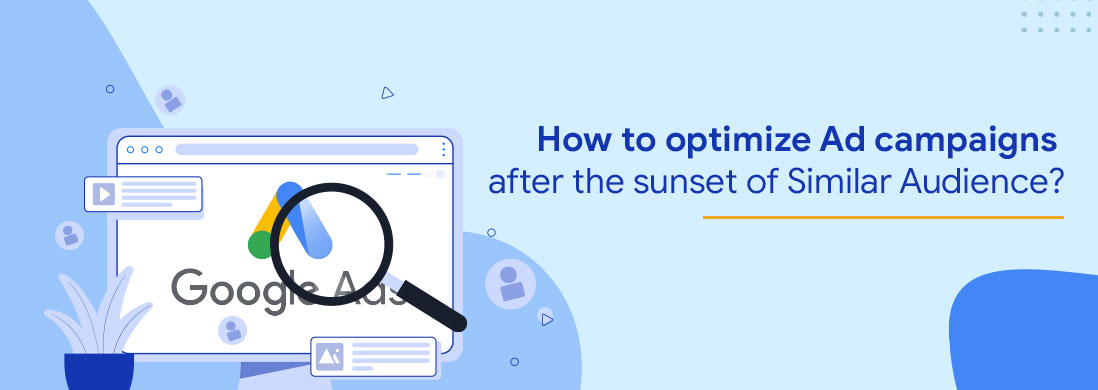With the discontinuation of Similar Audience, advertisers may wonder how they can optimize their advertising campaigns. This blog aims to shed light on alternative methods to enhance ad campaigns.
How “Similar Audience” is helping advertisers?
Similar Audience in Google Ads helps advertisers to efficiently reach out to their intended audience, as this enables them to gain significant knowledge of their target audience’s preferences.
Retargeting lets businesses communicate with customers that have already been to their website and engage with people who are already intrigued by their items and services.
Taking advantage of a Similar Audience can be advantageous for advertisers, as it allows them to increase their reach and bring in new customers by personalizing their advertising campaigns.
Similar segment targeting is available for the Display Network, Search Network, YouTube, Gmail, and App.
How do similar audiences work in Google Ads?
When it comes to Google Ads, similar audiences are a form of the target audience that the platform makes based on the properties of a “seed” audience that you give. This seed audience can be determined by a range of factors, for instance, people who visit your website, and the people who use your mobile application.
To create a similar audience in Google Ads, advertisers first need to select the seed audience and specify the size of the similar audience.
After Similar Audience is created, advertisers can apply it in their campaigns to target individuals who share similar traits to those in the seed group. This can be an effective way to reach potential customers who are most likely to buy your products or services.
Note:
It’s important to note that similar audiences are based on statistical modeling, rather than on explicit information about individual users, so the characteristics of the resulting audience may not exactly match those of the seed audience. Additionally, similar audiences are only available on types of campaigns, such as search and display campaigns, and may not be available for all advertisers.
When & Why are Similar Audiences going away?
From May 2023 google will stop generating similar audiences & cannot be added to campaigns & ad groups. Campaigns & ad groups having similar audiences will continue to run.
From August 2023 google will remove all similar audiences from campaigns & ad groups
This change will help advertisers to keep up with changes related to consumer behavior & online marketing strategy as the privacy environment changes rapidly.
Alternative methods that Advertisers can use to derive useful insights for their target audience
Despite fewer third-party cookies available, Google has developed solutions for advertisers to reach an engaged & relevant audience.
Strategies to optimize campaigns following the sunset of Similar Audience
There are a few strategies advertisers can use to optimize their Google Ads campaign without using similar audiences:
Keywords should be specific and relevant
Make sure that your ad campaigns are targeting specific and relevant keywords that are related to your product or service. This will help ensure that you are reaching the right audience.
Eliminate negative keywords
It is possible to eliminate certain words from your campaigns with negative keywords, so your advertisements will not be seen by people searching for those words. This can be useful in enhancing the pertinence of your ads and decreasing your cost-per-click (CPC).
Make use of ad extensions
Ad extensions provide more information about your business, services or products and can make an ad stand out among other ads. This can lead to higher click-through rates, increased engagement and more conversions. Ad extensions also make it easier for users to reach relevant businesses, which can lead to higher customer satisfaction.
Targeted ad groups are recommended
Using targeted ad groups is a great way to create more relevant and effective ads. By creating separate ad groups for different products or services, you can create ads that are tailored to each group and target specific keywords. This allows you to reach your desired audience more effectively, resulting in higher click-through rates, increased engagement, and potentially more conversions. Additionally, you can also set different bids for each ad group, which can help you optimize your advertising budget more effectively.
Utilize location-based targeting
Use location targeting to show ads only to people in certain countries, regions, or cities. This can help ensure that your ads are being shown to the right audience. By default, ads show to people in, regularly in, or who’ve shown interest in your targeted locations. Advertisers can select locations to exclude in campaigns if don’t want to show ads in specific regions
Target your audience by demographics
Use demographic targeting to show ads only to people of certain ages, genders, or interests. This can help ensure that your ads are being shown to the right audience. Demographic targeting helps in narrowing the targeting. One can add detailed demographic targeting to ad groups or campaigns.
Retargeting is always effective
Retargeting allows you to show ads to people who have visited your website before. This can be an effective way to remind potential customers about your products or services and encourage them to make a purchase.
Test and optimize
Use A/B testing to try different ad variations and see which ones perform the best. Regularly review the performance of your campaigns and make adjustments as needed to improve their effectiveness.
In conclusion, Google’s sunsetting of Similar Audience is a significant change for advertisers, but it presents an opportunity to optimize their campaigns through alternative methods. Advertisers can use targeted keywords and continually test and optimize their campaigns. By employing these strategies, advertisers can reach their desired audience effectively and improve the performance of their advertising campaigns.


